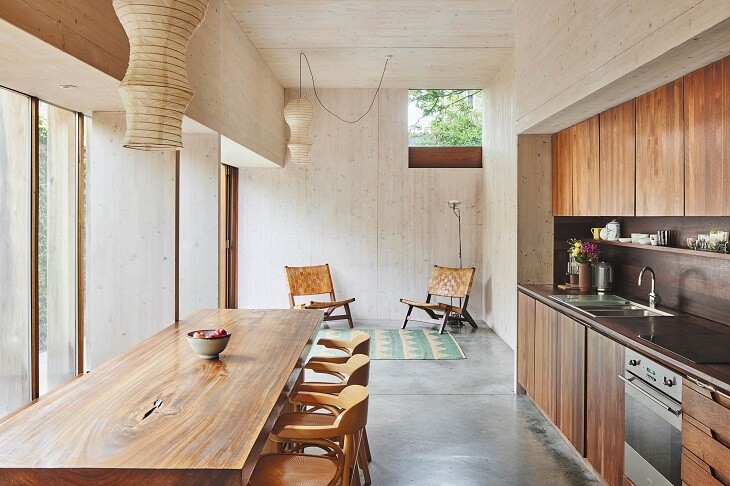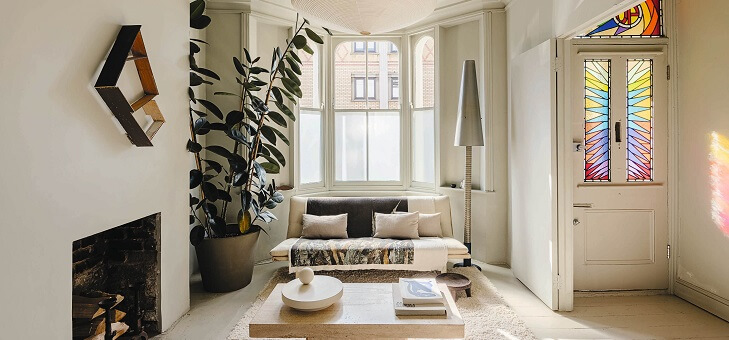Having a beautiful home has never felt more important than during the past 18 months when we’ve been forced to spend more time inside our own four walls – and you may have longed to transform yours into a beautiful modern living space.
But if a lack of know-how or limited finances held you back, it’s not too late to get started. Design guru Matt Gibberd insists it can be easy to create a gorgeous home without spending a fortune, just by implementing five simple design principles.
“If you ask me, a Palladian villa, for example, has the same sensibility as a masterpiece of the modernist era, and has been designed according to the same set of timeless principles,” he says.
“A simple way to think of these principles is to distil them into five categories – space, light, materials, nature and decoration.
“Paying careful consideration to each of these will allow you to create a home that’s beautiful, supportive and inspiring, regardless of scale or budget.”
Mr Gibberd, a founding director of the design-led estate agency The Modern House, has written the book, A Modern Way to Live, in which he outlines the five principles and how to best use them to create a beautiful home.
Here he gives us a taste of his principles.
1. Space

Mr Gibberd explains that when a home combines both space and ‘refuge’ areas it can help make occupants feel settled. He suggests: “Try to create an open and bright space for socialising, and a womb-like space for retreating and sleeping. Even in a studio flat, creating different zones using a curtain, sliding partition or bookcase on castors can greatly enhance the experience of occupying the space.”
You can create the illusion of space with mirrors and reflective surfaces, he says, by using natural niches for built-in cupboards, and continuing the same material from inside to out. Consider rehanging doors the other way around to open up rooms, and place radiators beneath windows to free-up valuable wall space for furniture.
And don’t forget the kitchen. Mr Gibberd advises homeowners to think of the kitchen as a collection of pieces of furniture rather than a set of units, and to avoid wall cupboards if possible, as the space above them becomes redundant. And instead of a freestanding fridge-freezer, consider a pair of under-counter refrigerators side by side.
Read: Design tips to create a kitchen you’ll love
And then there’s the bin. “A free-standing dustbin hangs around the kitchen like a foul-smelling Dalek, tripping people up and overflowing with the remains of yesterday’s dinner,” says Mr Gibberd. “Try to build in the rubbish solutions – the space beneath the sink is always a useful spot for food waste, for example.”
2. Light
Mr Gibberd says it’s better to consider fixed glazing with a conventional door alongside, rather than bifold doors. “A picture window – free of obtrusive handles and mechanisms – does a better job of framing the views and looks more beautiful because the structural supports are hidden,” he says.
He suggests avoiding Roman blinds and pelmets, and hanging curtains from extra-wide poles so they can be pulled back to reveal the full window.
If your home has more than one level, he suggests thinking about inverting the layout. “You might never get used to the idea of declaring, ‘I’m going downstairs to bed’,” he admits, “but in most other respects it makes a lot of sense, unlocking the light and views for the living spaces, and using the naturally darker areas lower down the building for sleeping.”
But although light is crucial for a home, Mr Gibberd says householders shouldn’t be afraid of the dark either. “Without areas of contrast, our homes would be one dimensional and monotonous,” he explains. “If you walk down a shadowy corridor, for example, when you arrive at a sun-soaked space it feels all the more bright and uplifting.”
And on a brighter note, Mr Gibberd says that if you can look straight into the filament of a lightbulb then it’s probably in the wrong place. “Shun ceiling lights in favour of task lighting, wall sconces and plug-in lamps that provide a gentler glow and better promote the circadian rhythm,” he suggests.
3. Materials
Mr Gibberd says householders should think carefully about the things they come into physical contact with every day, including light switches, door handles or kitchen worktops. “Are these as tactile as they should be?” he asks, pointing out that natural materials will always age more gracefully than man-made plastics and laminates. “Try to preserve original materials wherever possible, as they tell the individual story of a building and induce less anxiety than new ones,” he advises.
Mr Gibberd suggests living in a home for at least a year before making any changes. “For example, that wooden floor you thought was a bit beaten-up when you moved in might start to take on some significance – its warmth beneath bare feet, or its ability to absorb the comings and goings of daily life.”
Natural materials such as marble and glazed tiles have a gentle sheen and are easy to keep clean, he says, and clay is a moisture-absorbing alternative to conventional plaster.
It’s also worth thinking about the environmental impact of the materials you use, he says, pointing out that cork, for example, is naturally regenerative because the tree grows back its bark, and farms provide some excellent sources of eco-friendly insulation, including sheep’s wool and straw bales.
4. Nature
A connection to nature is vital for wellbeing, so a flat that overlooks a communal garden, or has deep window ledges that can hold plants is a boost, suggests Mr Gibberd.
If you’re lucky enough to have outdoor space, he suggests combining borders of shrubs and flowers with decking, compacted gravel or herringbones of brick.
And inside, stock up on the greenery. “Indoor plants positively impact our wellbeing, lowering blood pressure and increasing attentiveness, but they can also serve a practical purpose, helping to demarcate space, provide screening, absorb sound or add a flourish to an unremarkable room,” says Mr Gibberd.
Read: How to make your home a house plant haven
He suggests putting shells, pebbles and pinecones on the mantelpiece, using natural-looking paint colours, and hanging landscape paintings and photographs on walls.
5. Decoration
Instead of fitted carpets, Mr Gibberd suggests trying loose-laid natural floor coverings such as sisal and jute, with a gap between the edging and the wall. Use rugs in layers and let them fill the natural spaces between furniture.
And to avoid making an interior feel one dimensional, he says it can be a good idea to mix furniture and objects from different eras and places. “Rather than putting a set of matching chairs around the kitchen table, for example, throw a bench or a wobbly Windsor chair into the mix,” he suggests.
“Surround yourself with the objects that have the most meaning to you personally and tell the story of your life – family heirlooms, or things that remind you of a particular holiday or experience.”
He advises householders to avoid using a flat screen TV as a room’s centrepiece, and instead organise furniture traditionally around the hearth. Group furniture and objects together in odd numbers, he says, explaining: “If things are arranged asymmetrically, the eye is forced to move around them to fully absorb what it sees.”
And you may need to rethink the way your pictures are hung, he warns. “The most common mistake is to place them too high,” he points out. “My advice is to use your eye to find what feels like the right place instinctively, then take it down by six inches.”
Read: Seven interior design trends taking off
And finally, he says: “When choosing what to buy for your home, try to follow your instincts rather than any preconceived notions about what constitutes good taste. Many of the best things have not been celebrated on Instagram can’t be found in textbooks and don’t cost a great deal. Often, they have an accidental beauty that’s the result of fulfilling utilitarian needs.”

A Modern Way to Live by Matt Gibberd is available now.
Are you looking to renovate or redecorate in the near future? Will you be applying any of these home design tips? Please let us know in the comments section below.
– With PA
If you enjoy our content, don’t keep it to yourself. Share our free eNews with your friends and encourage them to sign up.

